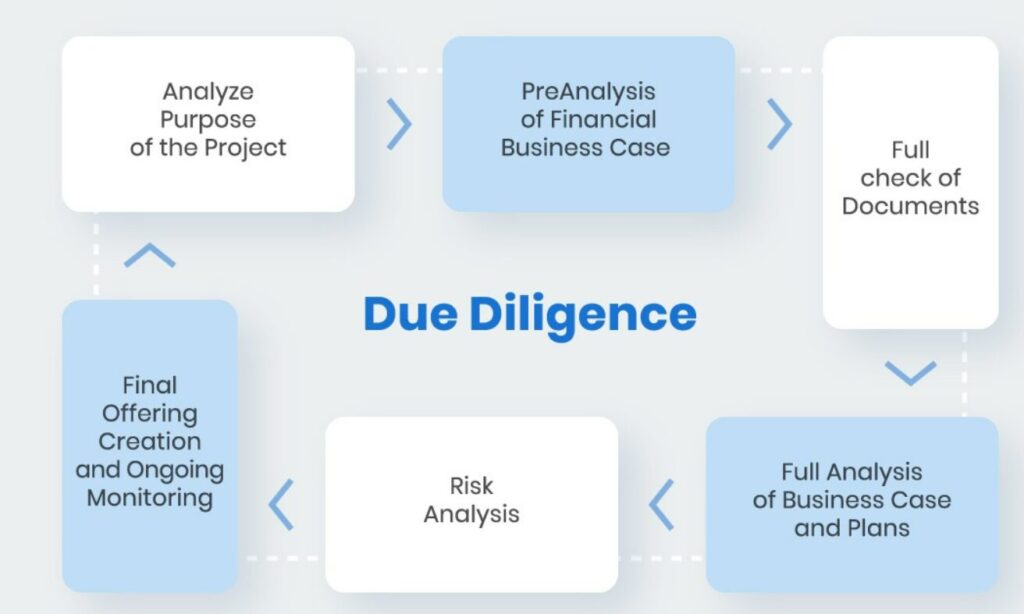Due Diligence Audit Report
A Due Diligence Audit Report typically contains detailed information about the findings and assessments conducted during a due diligence process. The report is essential for businesses, investors, or stakeholders to evaluate the risks and opportunities associated with a potential investment, partnership, acquisition, or other significant business decisions. While the specific contents of a Due Diligence Audit Report may vary depending on the nature of the investigation and industry standards, here are some common elements typically included. Know More

Due Diligence Audit Report
Executive Summary: A concise overview of the key findings, conclusions, and recommendations presented in the report.
Highlights of the most significant aspects and implications identified during the due diligence process.
- Introduction: Background information on the purpose, scope, and objectives of the due diligence audit.
Description of the business or transaction under review and its significance to the stakeholders involved.
- Methodology: Explanation of the approach, methods, and procedures used to conduct the due diligence audit.
Details of the data collection, analysis techniques, and sources of information utilized during the audit process.
- Financial Due Diligence: Analysis of the financial statements, including balance sheets, income statements, cash flow statements, and financial ratios.
Assessment of financial performance, trends, liquidity, solvency, profitability, and potential risks.
Examination of key financial metrics, accounting practices, and adjustments made during the audit.
- Legal Due Diligence: Review of legal documents, contracts, agreements, licenses, permits, regulatory filings, and litigation matters.
Identification of legal risks, liabilities, obligations, and potential legal disputes or issues affecting the business or transaction.
Evaluation of compliance with applicable laws, regulations, and industry standards.
- Operational Due Diligence: Assessment of the operational structure, processes, systems, capabilities, and efficiency of the business.
Examination of production facilities, supply chain management, inventory management, and distribution channels.
Identification of operational strengths, weaknesses, opportunities, and threats impacting the business operations.
- Commercial Due Diligence: Analysis of market dynamics, industry trends, competitive landscape, customer base, and revenue streams.
Evaluation of sales and marketing strategies, product differentiation, pricing policies, and brand reputation.
Assessment of market positioning, growth potential, and competitive advantages or disadvantages.
8. Risk Assessment: Identification and analysis of key risks, uncertainties, and contingencies associated with the business or transaction.
Evaluation of strategic, financial, operational, legal, regulatory, and market-related risks.
Recommendations for risk mitigation strategies, controls, and risk management practices.
- Valuation and Financial Modeling: Calculation of the enterprise value, equity value, and valuation multiples based on financial projections and assumptions.
Sensitivity analysis, scenario planning, and stress testing to assess the impact of different variables on the financial outlook.
Financial modeling techniques used to forecast future cash flows, earnings, and returns on investment
10.Conclusion and Recommendations: Summary of the overall findings, conclusions, and implications derived from the due diligence audit.
Recommendations for actions, decisions, and strategies to address identified risks, capitalize on opportunities, and maximize value creation.
Guidance on structuring the transaction, negotiating terms, and executing post-due diligence activities
11. Appendices: Supplementary information, supporting documentation, charts, tables, and exhibits referenced in the main body of the report.
Additional details on specific aspects of the due diligence audit, including legal opinions, expert assessments, and due diligence checklists.
12.Disclosure of Limitations: Disclosure of any limitations, constraints, or caveats associated with the due diligence process and findings.
Acknowledgment of the inherent uncertainties and assumptions involved in the evaluation of complex business transactions.
Types of Due Diligence
Financial Due Diligence:
Purpose: Assessing the financial health, performance, and viability of a business or investment opportunity.
Key Focus Areas: Financial statements analysis, revenue and cost analysis, cash flow assessment, asset valuation, liabilities review, taxation, accounting practices, and financial projections.
- Legal Due Diligence:
Purpose: Identifying legal risks, liabilities, obligations, and compliance issues associated with a business, transaction, or legal matter.
Key Focus Areas: Review of contracts, agreements, leases, licenses, permits, regulatory filings, litigation history, intellectual property rights, environmental compliance, and legal documentation.
- Operational Due Diligence:
Purpose: Evaluating the operational efficiency, effectiveness, and capabilities of a business or investment opportunity.
Key Focus Areas: Assessment of production processes, supply chain management, inventory management, distribution channels, technology infrastructure, human resources, and operational controls.
- Commercial Due Diligence:
Purpose: Analyzing market dynamics, industry trends, competitive landscape, and revenue-generating potential of a business or market opportunity.
Key Focus Areas: Market analysis, customer segmentation, competitive analysis, sales and marketing strategies, product differentiation, branding, and customer relationships.
- Regulatory Due Diligence:
Purpose: Ensuring compliance with laws, regulations, industry standards, and licensing requirements applicable to a business or investment.
Key Focus Areas: Regulatory compliance assessment, licensing and permit verification, environmental regulations, health and safety standards, data protection laws, and government approvals.
- Environmental Due Diligence:
Purpose: Assessing environmental risks, liabilities, and regulatory compliance associated with a property, project, or business operation.
Key Focus Areas: Environmental impact assessment, pollution risks, hazardous materials management, remediation obligations, regulatory compliance, and environmental sustainability practices.
- Human Resources Due Diligence:
Purpose: Evaluating the human resources practices, workforce capabilities, and employment-related risks of a business or investment opportunity.
Key Focus Areas: Organizational structure, employee contracts, compensation and benefits, labor laws compliance, employee relations, training and development, and workforce planning.
- Technical Due Diligence:
Purpose: Assessing the technical aspects, capabilities, and risks associated with technology-intensive businesses, projects, or investments.
Key Focus Areas: Technology infrastructure, product development lifecycle, intellectual property rights, software systems, cybersecurity, data protection, and technology scalability.
- Tax Due Diligence:
Purpose: Reviewing the tax implications, obligations, risks, and opportunities associated with a business, investment, or transaction.
Key Focus Areas: Tax compliance review, tax planning strategies, tax liabilities assessment, tax credits and incentives, transfer pricing, and potential tax exposures.
- Cultural Due Diligence:
Purpose: Understanding the organizational culture, values, norms, and leadership styles of a business or investment target.
Key Focus Areas: Organizational values assessment, leadership dynamics, employee morale, communication styles, and alignment with stakeholder expectations.
Reasons for Due Diligence Audit Report
Risk Assessment: Evaluate and identify potential risks, liabilities, and uncertainties associated with a business, investment opportunity, or transaction.
Understand the magnitude and impact of risks on financial, operational, legal, regulatory, and reputational aspects.
Decision Making: Make informed decisions regarding investments, acquisitions, mergers, partnerships, joint ventures, divestitures, and other strategic initiatives.
Assess the feasibility, viability, and compatibility of business opportunities with organizational objectives and long-term goals.
Value Assessment: Determine the true value, worth, and potential returns of a business, asset, or investment opportunity.
Validate assumptions, projections, and valuation models to ensure accuracy and reliability in financial and investment decisions.
Compliance Verification: Ensure compliance with legal, regulatory, contractual, and industry-specific requirements and standards.
Identify any gaps, deficiencies, or non-compliance issues that may pose legal, financial, or reputational risks to the organization.



Due Diligence for Mergers and Acquisitions (M&A):
Assess the financial, operational, legal, regulatory, and strategic aspects of target companies or businesses in M&A transactions.
Validate synergies, integration strategies, and potential risks associated with combining or divesting business entities.
Legal Protection: Mitigate legal risks, liabilities, and exposures by conducting thorough legal due diligence on contracts, agreements, intellectual property rights, regulatory compliance, and litigation matters.
Ensure legal protections and safeguards are in place to prevent disputes, lawsuits, and legal challenges.
Operational Efficiency: Identify opportunities for operational improvements, cost savings, efficiency gains, and performance enhancements within a business or investment portfolio.
Optimize operational processes, systems, and resources to drive productivity, profitability, and sustainable growth.
Investor Confidence: Build investor confidence, trust, and credibility by providing transparent, accurate, and reliable information about the organization’s financial health, operations, and governance practices.
Foster positive relationships with stakeholders, shareholders, lenders, and regulatory authorities through proactive due diligence practices.
Negotiation and Risk Management: Strengthen negotiation positions, terms, and conditions by leveraging insights and analysis derived from due diligence investigations.
Manage and mitigate risks effectively by identifying, prioritizing, and addressing key risk factors and vulnerabilities.
Strategic Planning: Inform strategic planning, resource allocation, and decision-making processes based on comprehensive due diligence analysis.
Align business strategies, goals, and initiatives with market trends, competitive dynamics, and emerging opportunities.
Stages in the Due Diligence Process
Planning and Preparation:
Define Objectives: Clearly define the objectives, scope, and focus areas of the due diligence process based on the specific context and requirements.
Assemble Team: Formulate a multidisciplinary team comprising professionals with expertise in finance, law, operations, regulatory compliance, and other relevant fields.
Develop Checklist: Create a due diligence checklist outlining key documents, information, and areas to be reviewed during the process.
- 2. Information Gathering:
Request Documents: Request and gather relevant documents, records, contracts, agreements, financial statements, regulatory filings, and other pertinent information from the target company or entity.
Data Room Setup: Set up a secure data room or virtual data room (VDR) to facilitate the exchange and access of confidential information between parties involved in the due diligence process.
- Preliminary Review:
Initial Assessment: Conduct a preliminary review of the provided documents and information to identify potential red flags, discrepancies, and areas requiring further investigation.
Risk Identification: Identify key risks, liabilities, legal issues, operational challenges, financial concerns, and other factors that may impact the transaction or decision-making process.
- In-Depth Analysis:
Financial Due Diligence: Analyze financial statements, cash flows, balance sheets, income statements, tax records, budgets, forecasts, and financial metrics to assess the financial health and performance of the target entity.
Legal Due Diligence: Review legal documents, contracts, agreements, litigation history, regulatory filings, intellectual property rights, compliance records, and other legal aspects to evaluate legal risks and liabilities.
Operational Due Diligence: Evaluate operational processes, systems, capabilities, supply chain management, production facilities, inventory management, and workforce dynamics to identify operational efficiencies and challenges.
Commercial Due Diligence: Assess market dynamics, industry trends, competitive landscape, customer segmentation, sales channels, marketing strategies, and revenue-generating potential to evaluate the commercial viability and growth prospects of the target entity.
- Site Visits and Interviews:
On-Site Inspections: Conduct on-site visits, facility tours, and inspections to gain firsthand insights into the operations, infrastructure, facilities, and working conditions of the target entity.
Management Interviews: Interview key management personnel, executives, and stakeholders to obtain additional information, clarification, and perspectives on critical issues and strategic priorities.
- Analysis and Reporting:
Data Analysis: Analyze the collected data, findings, and observations to identify trends, patterns, correlations, and outliers relevant to the due diligence objectives.
Risk Assessment: Assess the identified risks, opportunities, strengths, weaknesses, threats, and mitigating factors associated with the target entity or transaction.
Due Diligence Report: Prepare a comprehensive due diligence report summarizing the findings, analysis, conclusions, recommendations, and risk mitigation strategies for presentation to stakeholders.
- 7. Decision Making:
Decision Criteria: Evaluate the findings and recommendations against predefined decision criteria, investment parameters, risk tolerance levels, and strategic objectives.
Risk Management: Determine appropriate risk management strategies, contingencies, and mitigation measures to address identified risks and uncertainties.
Go/No-Go Decision: Make informed decisions regarding the continuation, modification, or termination of the proposed transaction, investment, or business venture based on the outcome of the due diligence process.
- 8. Negotiation and Documentation:
Negotiation Strategies: Develop negotiation strategies and tactics based on insights gained from the due diligence process to secure favorable terms, conditions, and outcomes.
Document Review: Review and finalize legal agreements, contracts, transaction documents, and closing documents with appropriate legal, financial, and regulatory oversight.
Execution and Closing: Execute the transaction, investment, or business deal in accordance with the negotiated terms and conditions, ensuring compliance with legal and regulatory requirements.
- Post-Closing Integration:
Integration Planning: Develop integration plans and strategies to seamlessly integrate the acquired business, assets, or operations into the existing organizational structure and processes.
Stakeholder Communication: Communicate effectively with stakeholders, employees, customers, suppliers, and other relevant parties to ensure a smooth transition and continuity of operations.
Monitoring and Evaluation: Monitor post-closing performance, track key performance indicators (KPIs), and conduct periodic evaluations to assess the effectiveness of integration efforts and achieve synergy targets.
What are the Sections of a Due Diligence Report?
Executive Summary: Provides a high-level overview of the key findings, conclusions, and recommendations derived from the due diligence process.
Summarizes the purpose, scope, methodology, and major highlights of the report for quick reference.
Introduction: Introduces the purpose, objectives, and scope of the due diligence analysis.
Provides background information on the subject of the due diligence, including the target company, investment opportunity, transaction, or legal matter.
Methodology: Describes the approach, methods, and procedures used to conduct the due diligence analysis.
Explains the data collection, research, analysis techniques, and sources of information utilized during the due diligence process.
Overview of the Target Entity: Provides a detailed overview of the target company, business, or asset under review.
Describes the industry, market position, products, services, customers, competitors, and other relevant background information.
Financial Due Diligence: Analyzes the financial health, performance, and viability of the target entity.
Includes analysis of financial statements, cash flows, balance sheets, income statements, financial ratios, and other financial metrics.
Legal Due Diligence: Evaluates legal risks, liabilities, and compliance issues associated with the target entity.
Reviews contracts, agreements, leases, permits, licenses, intellectual property rights, regulatory filings, litigation matters, and other legal documentation.
Operational Due Diligence: Assesses the operational efficiency, capabilities, and risks of the target entity.
Reviews operational processes, systems, supply chain management, production facilities, inventory management, and workforce dynamics.
Commercial Due Diligence: Analyzes market dynamics, industry trends, competitive landscape, and revenue-generating potential of the target entity.
Evaluates market positioning, customer segmentation, sales channels, marketing strategies, and growth opportunities.
Risk Assessment: Identifies key risks, uncertainties, and vulnerabilities associated with the target entity or transaction.
Provides a comprehensive assessment of strategic, financial, operational, legal, regulatory, and market-related risks.
Findings and Observations: Presents detailed findings, observations, and insights derived from the due diligence analysis.
Highlights strengths, weaknesses, opportunities, and threats identified during the review process.
Recommendations: Provides actionable recommendations, strategies, and risk mitigation measures based on the findings of the due diligence analysis.
Offers guidance on addressing identified issues, optimizing opportunities, and enhancing the overall value proposition.
Conclusion: Summarizes the main findings, conclusions, and implications of the due diligence analysis.
Provides closing remarks and emphasizes key takeaways for stakeholders and decision-makers.
Appendices: Includes supplementary information, supporting documentation, charts, tables, exhibits, and reference materials referenced in the main body of the report.
Provides additional details on specific aspects of the Due Diligence Audit Report for further reference.
What Elements of a Due Diligence Report of a Company Are Crucial?
Executive Summary:
Importance: Provides a concise overview of the key findings, conclusions, and recommendations derived from the due diligence process.
Crucial Details: Summarizes the purpose, scope, methodology, major highlights, and implications of the due diligence analysis.
- Financial Analysis:
Importance: Evaluates the financial health, performance, and stability of the company.
Crucial Details: Analysis of financial statements, cash flows, balance sheets, income statements, financial ratios, and key financial metrics.
- 3. Legal Assessment:
Importance: Identifies legal risks, liabilities, and compliance issues associated with the company’s operations and contracts.
Crucial Details: Review of contracts, agreements, licenses, permits, regulatory filings, litigation history, intellectual property rights, and legal documentation.
- Operational Review:
Importance: Assesses the operational efficiency, capabilities, and risks of the company’s business operations.
Crucial Details: Examination of operational processes, systems, supply chain management, production facilities, inventory management, and workforce dynamics.
- Market Analysis:
Importance: Analyzes market dynamics, industry trends, competitive landscape, and revenue-generating potential of the company.
Crucial Details: Assessment of market positioning, customer segmentation, sales channels, marketing strategies, and growth opportunities.
- Risk Identification:
Importance: Identifies key risks, uncertainties, and vulnerabilities associated with the company’s business model and industry environment.
Crucial Details: Comprehensive assessment of strategic, financial, operational, legal, regulatory, and market-related risks.
- Compliance Verification:
Importance: Ensures compliance with legal, regulatory, contractual, and industry-specific requirements and standards.
Crucial Details: Evaluation of regulatory filings, licensing, permits, environmental regulations, data protection laws, and government approvals.
- Management and Personnel:
Importance: Assesses the quality, experience, and effectiveness of the company’s management team and key personnel.
Crucial Details: Review of management structure, leadership capabilities, organizational culture, employee morale, and succession planning.
- Growth Potential and Opportunities:
Importance: Identifies growth opportunities, competitive advantages, and potential areas for business expansion.
Crucial Details: Evaluation of product innovation, market penetration strategies, mergers and acquisitions, partnerships, and diversification opportunities.
- Recommendations and Actionable Insights:
Importance: Provides actionable recommendations, strategies, and risk mitigation measures based on the findings of the due diligence analysis.
Crucial Details: Guidance on addressing identified issues, optimizing opportunities, and enhancing the company’s overall performance, competitiveness, and value proposition.
- Conclusion and Summary:
Importance: Summarizes the main findings, conclusions, and implications of the due diligence analysis.
Crucial Details: Closing remarks emphasizing key takeaways, decision points, and implications for stakeholders and decision-makers.
